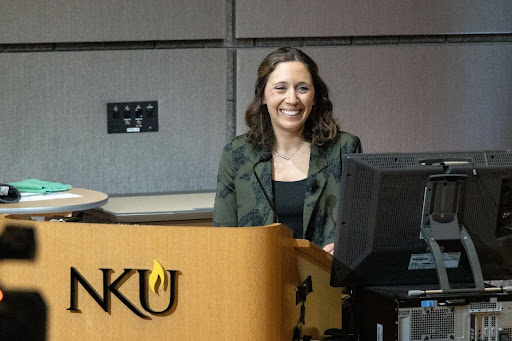
A 15-year-long tradition continued Thursday evening as executive editor of The Associated Press Julie Pace spoke at the Six@Six Lecture Series, an event run by Northern Kentucky University Scripps Howard Center for Civic Engagement. At the event, Pace discussed the challenges that the journalism industry faces, especially in the age of technology.
Before the lecture, Pace met with journalism and electronic media and broadcasting students for a question-and-answer session where similar discussion took place. Students were curious to know the connections between theories on cultivation and algorithms, as well as how The Associated Press is working to uphold non-partisan standards with the rise of artificial intelligence (AI).
Many of these students, as well as community members, then met in NKU’s Digitorium Thursday evening to further the discussion and bring in new conversation. Pace broke down three of the main challenges in journalism today:
- How does the AP uphold its mission to provide non-partisan news in a divided world?
- With the rise of misinformation, how does the AP prioritize fact?
- What are the positives and negatives to AI and its use in journalism?
Pace started the conversation with a breakdown of the history of the AP. By understanding where the business got its start, Pace was able to showcase how the news publication’s values are integrated into the work it produces. Emphasis on the business model of the organization and its need to reach audiences of all backgrounds and opinions is one of the key reasons why the business strives for non-partisanship. If a partisan position is taken, the audience that can be reached is lessened, Pace said. For The Associated Press to succeed, it needs to reach a variety of audiences. Focusing on facts allows for the organization to appeal to each of these audiences, rather than just a few.
With that, Pace introduced the discussion of how misinformation and its rise due to technology can lead to challenges in the AP’s focus on facts. Pace brought in the conversation from the student question-and-answer session about the power of algorithms. Once someone interacts with misinformation, algorithms will continue to show misinformation in their feeds. From there, it “becomes all consuming,” said Pace.
Because misinformation can spread so quickly, Pace and the AP are committed to showing their work to their audiences, not repeating misinformation, and reaching people where they are through a variety of platforms. “Yes, we are on TikTok. If there are people there and there’s misinformation there, we want to make sure that we’re there asserting that fact-based reporting into the conversation,” the editor said.
The added challenge of AI made it to Pace’s list of struggles within the industry of journalism.
“If we were having this conversation a year ago, AI would probably not have been on here as one of the top challenges facing the news industry. It simply was not a significant part of the conversation. But it really underscores just how fast the landscape around us is changing,” Pace said.
Pace discussed the need to be a part of the conversation with AI companies to help the industry move forward in an ever-changing world of technology, as well as the benefits of integrating it into journalism. She used an example of how the AP has used AI in the past to automate sports scores. With this integration of technology, journalists were then able to move “into roles where there was more emphasis on creating original content, doing source reporting, analysis, the kinds of things that we truly believe only human journalists can do,” Pace explained.
The Associated Press feels that transparency is vital, especially with the use of artificial intelligence. All published content that was generated by AI is labeled for the public.
The lecture ended with a question-and-answer session between the audience and Pace, where attendees were able to further the conversation posed by her speech, as well as dive into new concepts surrounding journalism today.
“I feel like a lot of my job is trying to explain to people just how seriously we take our role as being a fact-based non-partisan user organization, and just how deeply that runs through everything we do,” said Pace. “It’s important to me to be able to have these kinds of conversations and make sure that that gets across.”

